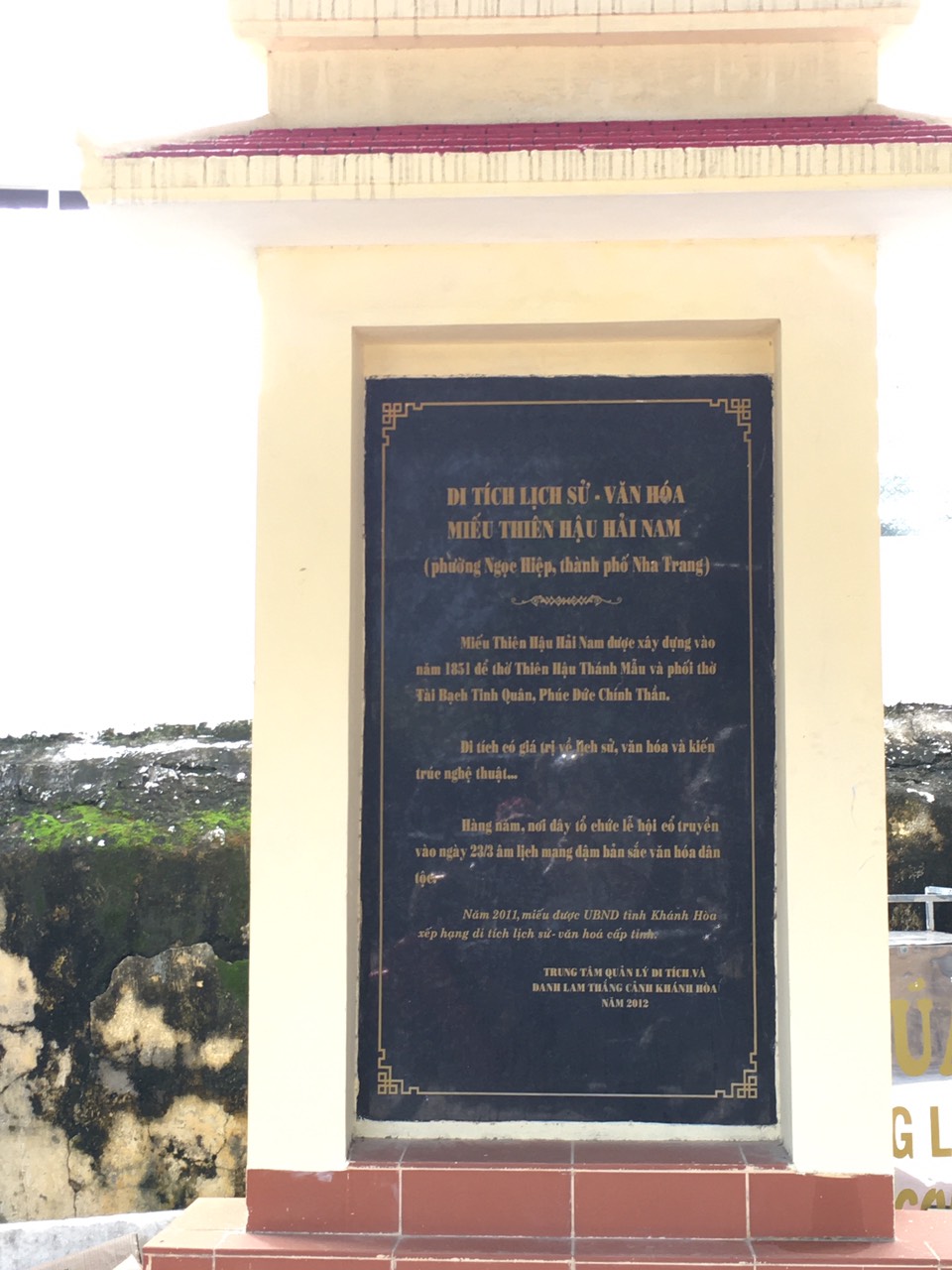Description
Thien Hau Hai Nam Temple is located in Ngoc Hiep Ward, Nha Trang City, Khanh Hoa Province.
The history of large-scale migration from China to Vietnam starting in the 16th and 17th centuries paved the way for the commercial services of the Chinese in Guangdong, Fujian, Chaozhou and Hainan provinces - China. to the South Central provinces and the Southern regions of Vietnam.
Thien Hau Temple of Hai Nam was built by Vietnamese Chinese people in Hainan who came to live and do business in Vinh Diem to worship Thien Hau. Under the Nguyen Dynasty, this area belonged to Dong An village, Vinh An commune, Xuong Ha canton, Vinh Xuong district, Dien Khanh district, Binh Hoa town.
According to scholar Vuong Hong Sen, her name is My Chau, belonging to Bo Duong (Phuoc Kien), born on March 23, Giap Than year (1044), during the reign of King Tong Nhan Tong. Then, when she was eight years old, she could read, and at eleven she became a Buddhist monk. At the age of thirteen, she received the poetry of the gods: the god of martial arts came down to give a set of "Original Secrets" and she found another stack of ancient books under the well, and then followed that to practice and attain enlightenment.

Once her father named Lam Tich Khanh sat on a boat with her two brothers (her brother), carrying salt to sell Jiangxi province, in the middle of the boat was hit by a big storm. saving her father and brother, she used her teeth to bite the cross of her father's shirt, holding both of her brothers, in the middle of which her mother called out to her and forced her to answer, she just opened her lips to answer when the waves swept her father away, only saving Since then, every time a boat is out at sea, people often worship her and ask for her help. In the Year of the Tiger (1110), the Song Dynasty ordained her as "Thien Hau Thanh Mau", because of that sacredness, the Chinese people in general and the Hainan people in particular respected her very much, and she was brought into worship right after. when building the Temple.
Hainan people have a long tradition of worshiping Lady Thien Hau, wherever they go, once they have settled and gradually settled down in a new place, the first thing is to set up a temple to worship her. The same goes for the establishment of a temple in this Cho Moi (Vinh Diem) area. This area later developed into Thi Tu Vinh Diem - one of the busiest commercial ports in Khanh Hoa province. The Hainan (China) people who came to trade and trade saw favorable natural conditions and sparse population, so they migrated here to settle down. Boats from Hainan come here to do business, goods are circulated by sea. In the year of the Rooster (1837), overseas Chinese from Hainan mobilized to raise money to buy land to build a Temple to have a place to worship and worship Ba.
In 1851 (Tan Hoi) Temple completed and carried out the rituals to bring her into worship.
Over a period of more than a century, the relic has been restored many times, but the current architecture is that of the 1992 restoration. However, during the restoration process, the construction items and buildings remain the same. The architectural part only replaces the old rotten tile.
Hainan Thien Hau Temple was built on an open campus, including 3 main works: Nghi Mon, Temple, and Tu Linh Street.
The ritual has two parts: the external ritual and the internal ritual. Through Nghi Mon interior is the Temple and divided into two main parts: The money is built one step higher than the yard, there are 4 columns supporting the roof through two trusses designed in the style of truss roof. The four sides are blank, only two rows of columns are left, the sacrifices are hung with horizontal paintings, on the rows of columns and columns are hung pairs of opposites. In the middle of the Pre-Sacrificial space, there is an altar to the Council, above which are displayed incense burners, lampstands and valuable magnetic objects.
Behind the two wooden pillars are two square stone columns forming a gap connecting the porch before entering the main hall, in this part of the porch is a special highlight of the monument; The entire wooden architecture here is decorated and carved with Chinese stories.
The main hall is made up of two sets because the roof structure is a variant of the gong rack, and the beams support the roof system. The back wall is built up to the roof. In the middle of the main hall, there is a wooden altar with incense burners, copper tops and magnetic objects. Inside is a wooden temple to worship Thien Hau, which is decorated quite splendidly, carved with delicate patterns and mascots; Above is the statue of Ba, in front of it is the kanji tablet; On both sides of the altar, there is a set of bowls of high artistic value.
The east and west walls are two shrines to worship Phuc Duc Chinh Than and Tai Bach Tinh Quan. Every year, Thien Hau Temple in Hai Nam organizes a big offering on the 23rd day of the third lunar month, which is the day of the Virgin Mary. Besides, the shrine also worships on the full moon days, the first and 5th of May; 9/9.
In 2011, Hai Nam Thien Hau Temple was issued by Khanh Hoa Provincial People's Committee Decision No. 526/QD - People's Committee ranked as a provincial historical - cultural relic.